A New Dawn: Echizen Lacquerware and Transforming Tradition
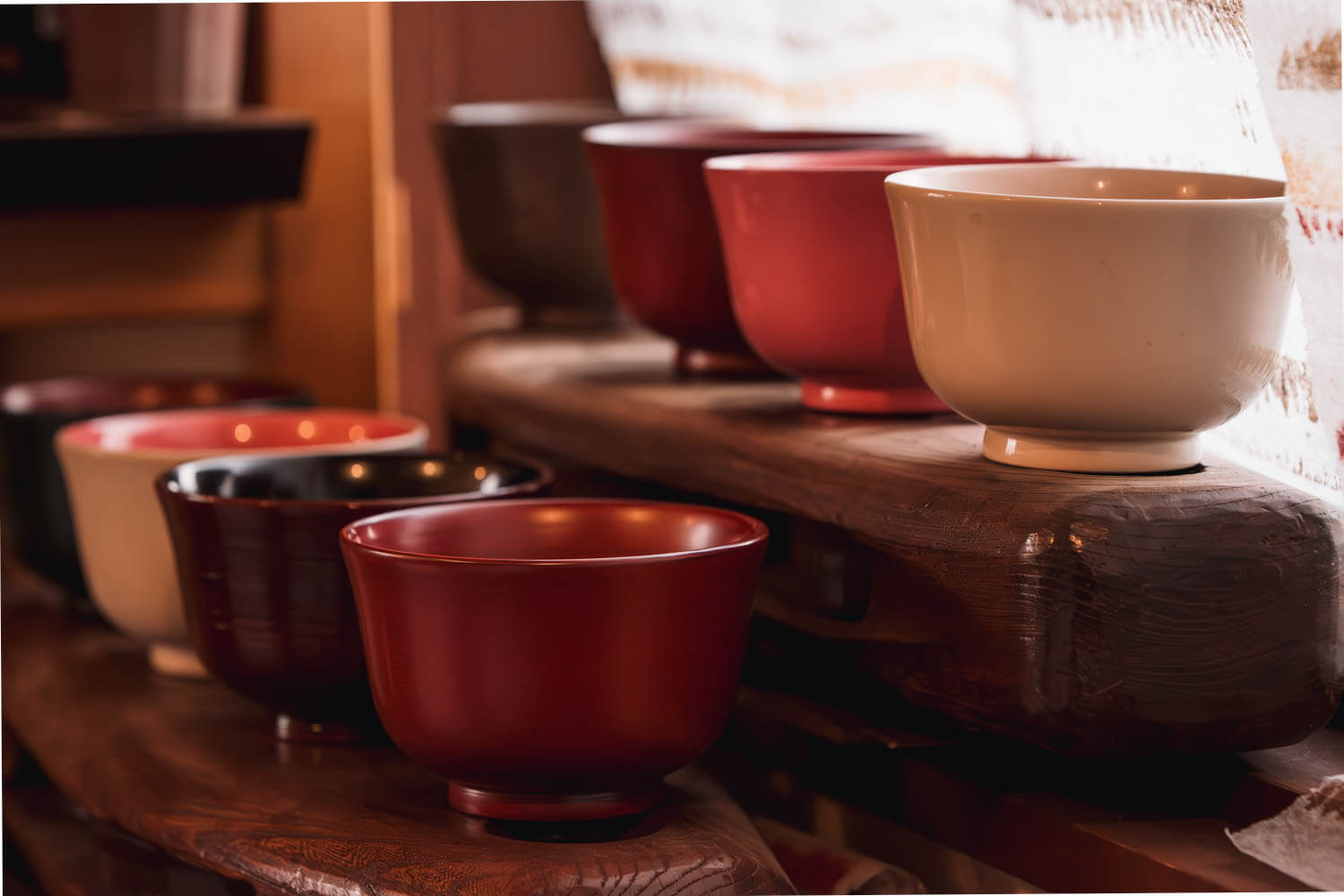
Spanning over 1,500 years, the allure of Echizen Lacquerware from Sabae, Fukui Prefecture, resonates through time, captivating hearts across eras. In a world dominated by mass production, the delicate artistry of this craft stands in poetic contrast to the churn of machines. However, it must be acknowledged that Japan's crafts industry has been navigating tumultuous waters. The shadows of Covid and global economic recession loom large, and Sabae's artisans find themselves caught in a turbulent market, contending with the relentless pace of mass manufacturers. This is further exacerbated by the perception of waning youth interest in traditional crafts; although senior craftsmen are responsible for their student’s well-being, apprentices are still required to dedicate at least three years of working without pay as part of their training. In this increasingly harsh economic environment, the quest for successors has become all the more poignant.
But Sabae's artisans are not just craftsmen; they are visionaries. Here at Kyomi, we journey into the heart of their world, discovering how innovation and sustainability feature as their compass in these changing tides. Presented with the privilege of interviewing a young craftswoman, we also share her insights on the aspirations of Sabae’s new generation of artisans and the future they envision for lacquerware in a globalized world. Join us on this voyage into Sabae’s ancient craft, and watch as the horizon unveils the dawn!
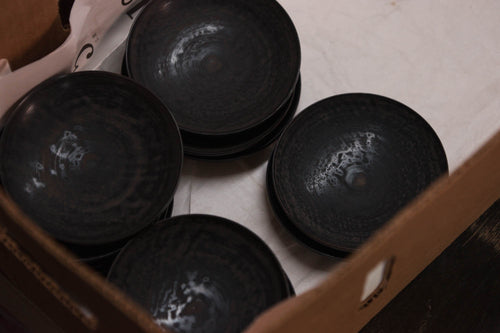
Innovation and Sustainability in Echizen Lacquerware
As brands across the globe respond to the climate change crisis, the trend towards sustainability has proven to be not just a passing fad, but a fundamental shift in consumer behavior. Not only did the Global Web Index 2022 report indicate that 68% of consumers consider a brand's social and environmental commitments when making a purchase, but McKinsey also found that 70% of consumers are willing to pay a premium for sustainable products. In response, major companies like Unilever and Patagonia have integrated sustainability into their brand identity, with Patagonia’s "Don't Buy This Jacket" campaign emphasizing the value of reusing products.
With their long history of creating durable, handcrafted products, the Echizen lacquerware community has long been a bastion of sustainability. From the Urushi lacquer harvested from local trees to the timber sourced from Fukui's own forests, every element in the crafting process is responsibly and locally sourced, each purchase nourishing an entire network of woodworkers and painters. This is not to mention their age-old practice of Kintsugi, which elevates the repair and reuse of broken items to an craft rich in aesthetic and philosophical depth.
In recent years, the craftsmen have also found new ways to minimize wastage in the production process, transforming what was once considered rubbish into items both practical and delightful. During the meticulous lacquer painting process, the artisans noticed that paper rags, once used to wipe away excess paint, evolved into canvases streaked with vermillion —perfect for repurposing as ethereal, semi-translucent curtains. Similarly, rags used for filtering lacquer morphed into unique Wabi-sabi jewelry and chopstick rests when dried and twisted. Even clamshells find new life as elegant trinket dishes, once glossed with a layer of transparent lacquer. When Kyomi visited their production house, the craftsmen welcomed us into a sitting room adorned with these small innovations. As sunlight danced through the patterned screens, casting brush-like shadows along the walls, these repurposed pieces stood as quiet testaments to the precision and dedication that gave them life.
As the craftsmen patiently explained the stories behind each recycled piece, one thing became abundantly clear: sustainability for them is not an advertising gimmick, but an ethos intrinsic to the philosophy of Echizen lacquerware. In an era of fast fashion and machine-made products, their unwavering commitment to crafting pieces to last a lifetime feels like an antidote to the recklessness of modern consumerism. It’s a commitment that Kyomi believes will continue to propel them into a future of global relevance.
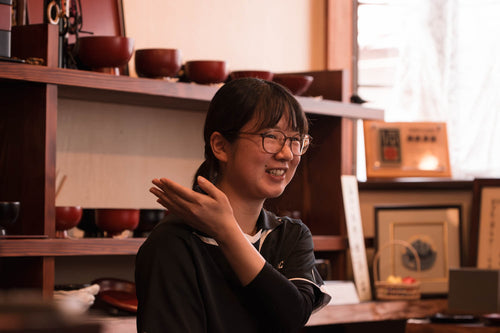
The Journey of a Young Artisan: Interview with Sato Chiho
During our visit to Sabae’s lacquerware houses, Kyomi had the privilege of conversing with Sato Chiho, a newly independent craftswoman in the realm of lacquerware painting. Fresh from a three-year tutelage in Kyoto's traditional crafts schools, she chose to specialize in lacquerware and moved to Sabae, apprenticing under master craftsmen such like Shoichi Hatakenata. Now, she stands as an independent artisan, responsible for middle-layer painting in the production process.\
“I wanted to work as an artisan,” she said, her tone polite but firm. “Not an artist.” She then elaborated on this distinction: — while an artist may independently conjure designs for others to replicate, an artisan is bound to a disciplined process, ensuring each creation of consistent quality. It was this ethos, she revealed, that guided her through the rigorous training in Kyoto. Her aspiration? To craft objects that “many people can use”, gifts that would imbue their everyday lives with subtle joy.
As we delved into her future visions for Echizen lacquerware, her eyes sparkled. She gestured toward the tableware before us — a coffee cup and saucer set that heralded a new chapter in their oeuvre. Though not traditional lacquerware items, these pieces are part of an effort to expand the artisans’ range of products. Ms Sato then spoke of her desire to experiment with color within the medium of lacquer — the signature warmth emanating from Echizen lacquerware stems from their use of Kodaishu, which translates literally to ’ancient red’. A rich shade of vermillion, lacquerware in Kodaishu is traditionally considered to be best suited for use in winter and autumn. While this lends a poetic seasonal resonance to the craft, it also narrows the range of possible products. Rather than conforming to the trend of simply introducing brighter colors, Chiho aims to reimagine Kodaishu, to use it to "express different feelings" and transcend its customary associations. As she unfurled her ambitions, her palpable enthusiasm was undeniably infectious.
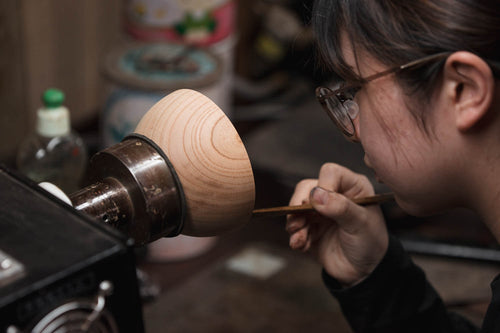
Nurturing Craftsmanship: The Community and its Women
Intrigued by her avant-garde aspirations, Kyomi asked if Sabae provided a support system for young craftsmen like herself. “Of course,” she replied, laughing. The town not only provides financial subsidies for budding artisans to work there, but its traditional crafts association also hosts monthly gatherings for craftsmen of various art forms — including those making washi paper, lacquerware, and traditional blades — to exchange ideas and conduct cultural lectures. The latter is particularly educational for the younger artisans, Ms Sato explained, because they allow them to refine techniques and deepen their understanding of their craft. Moreover, these forums serve as fertile ground for for the young craftsmen to mingle and discuss innovative ideas. Dispelling the stereotype that Japanese youth are disengaged from traditional crafts, Ms Sato revealed that many of her Kyoto schoolmates are migrating to Fukui Prefecture, cultivating a thriving artisanal culture that she finds extremely inspiring.
When probed about the challenges of being a young craftswoman in a predominantly traditional industry, Chiho paused, weighing her words. She acknowledged that her journey had been largely positive, guided initially by a seasoned craftswoman. Nonetheless, she shared her desire to be recognized as a professional artisan rather than simply a potential wife. Sabae has a small, close-knit community, she confided, and its intimacy sometimes veers into the personal, prompting questions about marital plans. While she sincerely values her inclusion in this communal tapestry, her ambition is to be seen as a professional, able to remain in Sabae because of her skill and not because she’s married to a resident. “I want to overcome the stereotype that marriage is the only way for women to stay here,” she said, her resolve unflinching. “That they can prove themselves and contribute to Sabae through their skill.” (At this point, her interviewer, also a young woman, nodded enthusiastically). Ms Sato's vision extends beyond her own journey; for future generations, she aspires to prove that it is possible to make a living as an artisan, to illuminate the path to a thriving, globally relevant crafts industry.
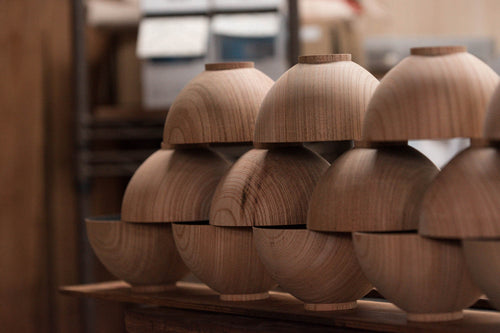
Tradition with Technology: The New Wave
Now to address the elephant in the room — given the relentless churn of mass production, how do the craftsmen keep up?
The first layer of their response lies in technological innovation. Over the past two decades, the integration of tools like turning tables, auto-revolving drying racks, and lacquer sprays has revolutionized their production process. While the soul of the craft—the painting and carving—remains a manual endeavor, these innovations serve as extensions of the artisans' hands, enhancing their speed, precision, and overall productivity. The foot-pedal-operated turning tables, requiring an operation akin to a driving a car, still stand as a testament to their remarkable hand-eye coordination. Collectively, these technological aids have enabled the artisans to mitigate production costs and keep abreast with the market.
Yet, as senior craftsman Shinya Hatakenaka elucidated, these tools find their calling in lower-cost, mass-produced items like spoons or chopstick rests. When it comes to Echizen's high-end lacquerware, especially those requiring both precision and artistic flare like Maki-e, the touch of a master craftsman remains irreplaceable. This brings us to an insight shared by all the artisans Kyomi engaged with: the future will have room for both machine-made and handcrafted products, each product with its own audience, not in competition but in a collaborative coexistence. Each has its strengths and weaknesses — while machine-made items captivate with their vibrant colors and affordability, traditional crafts command a premium for their durability and nuanced elegance. Echizen lacquerware is hand-crafted and takes longer to create, but the craftsmen believe that there will always be a need for it. Given its ceremonial significance in Buddhist rituals and coming-of-age ceremonies, its cultural roots run deep, making it an enduring necessity of socio-historical significance, forged with materials from the natural landscape of Fukui prefecture itself.
This segues into Ms. Sato's closing reflections—the need for modern craftsmen to become their own advocates in a global marketplace. Gone are the days when you could be a stony, genius craftsman, she declared. In a world connected by social media and global commerce, artisans must now independently “speak for the value of products”. This involves not narrating their stories to a global audience—a challenge that the digitally-savvy younger generation of craftsmen is eager to undertake. Here at Kyomi, we can’t wait to see the innovative tapestries they will weave into the world.

Conclusion
In a world increasingly enamored with the disposable, Echizen lacquerware stands as a poetic ode to the lasting and the meaningful. Sabae is a town where tradition whispers and innovation listens, housing a new generation of artisans who are scripting a new chapter in an ancient tale, one brushstroke at a time. Amidst today’s turbulence, their ability to ride the waves of sustainability and technology is a testament to the resilience of human creativity. It reminds us that tradition can be a living, breathing entity, enriching our present and informing our future. So let us cherish their creations, and participate in an ongoing story that has captivated us for over a millennium.
The dawn is bright along the horizon. Can you see it? It’s a specific shade of vermillion, at once ancient yet new.
Ready to explore our wide range of products? Visit our catalog page now and discover the perfect items for your needs!
